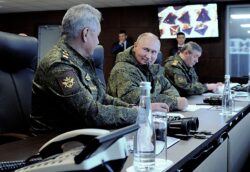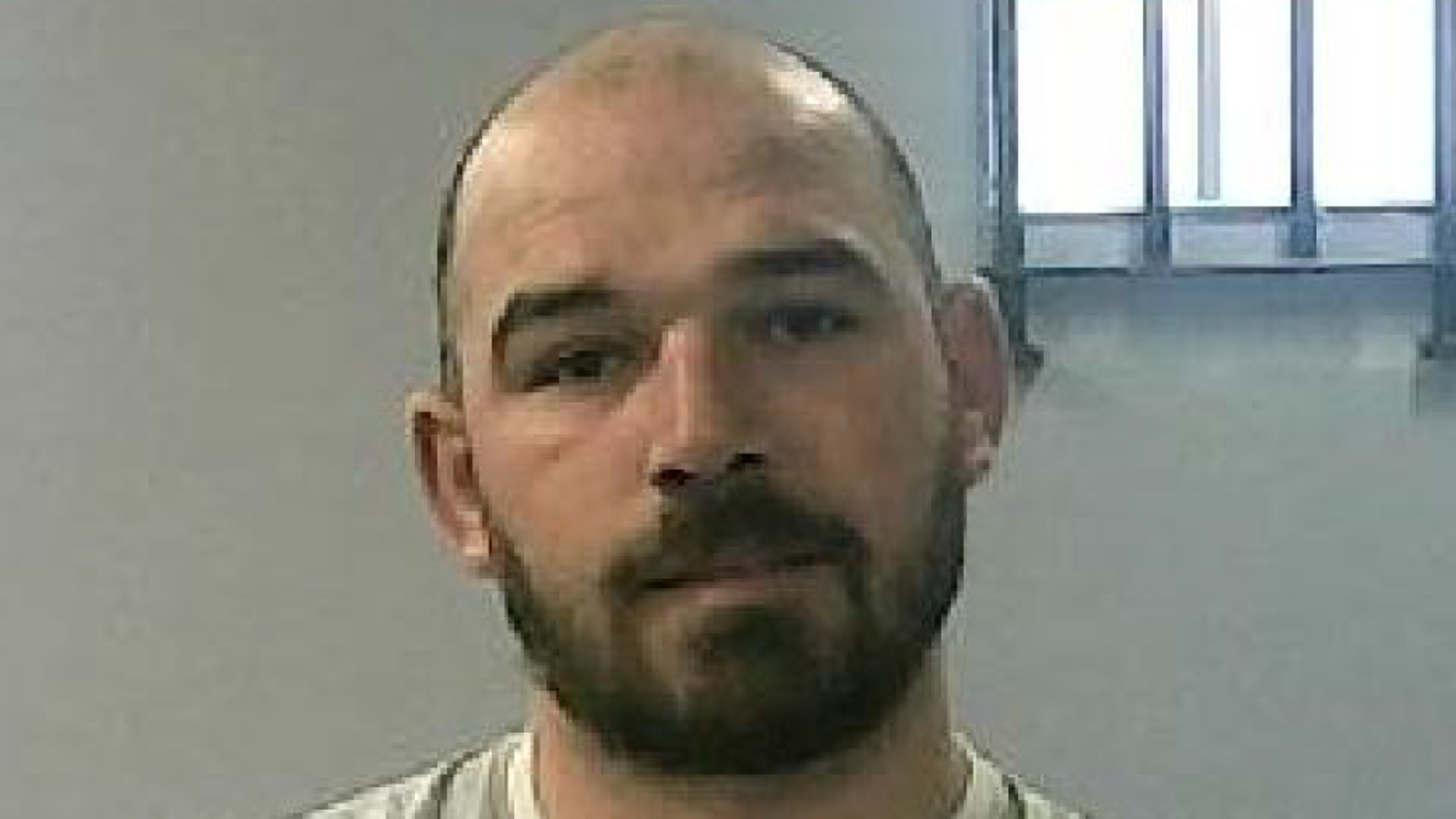For 13 tense days in October 1962, the world held its breath.
The Cuban missile crisis is regarded as the closest humankind has come to Armageddon.
However some believe the doomsday clock is ticking faster in light of Vladimir Putin’s faltering invasion of Ukraine and his continued threats of mass destruction.
The Russian president has opened the possibility of a ‘tactical’ nuclear strike that could still carry more destructive force than the atomic bomb dropped by the US on Hiroshima in 1945.
As Moscow is humiliated on the battlefield by a series of counter-offensives, one analyst raised the prospect of a ‘cornered nation’ unlikely to back down over a country on its doorstep.
Defence experts have judged the threat to be low but the fact that humanity-level weapons are even being discussed has led to grave concerns in Western nations.
The British military historian Max Hastings has said Mr Putin’s unpredictability compared with his Cold War predecessor, Nikita Khrushchev, is contributing to a situation that is ‘arguably’ graver than the nuclear precipice facing the world 60 years ago.
Vladimir Putin (centre) is shown with Russian Defence Minister Sergei Shoigu (right) and Chief of the Russian General Staff Valery Gerasimov (Picture: EPA)
Senior political scientist Michael Mazarr, of US-based research group the RAND Corporation, points out that, while Cuba was the most famous nuclear confrontation, there were other theatres, including Berlin, Korea, Suez and Vietnam, when the threat remained in the background.
‘Cuba was probably the time when nuclear weapons came closest to being used — including the famous case of the Soviet submarine officer who stopped the firing of a nuclear-tipped torpedo,’ Mr Mazarr said.
‘In some ways the threat level is lower today than at those peak threat moments of the Cold War: There hasn’t been the same fear of nuclear-first strikes or the atmosphere of a global zero-sum confrontation.
‘As far as we know from public reports, for example, the nuclear forces of each side have not gone to high alert. But in other ways, in terms of the local conflict, it’s more dangerous.
‘Russia has much more significant interests at stake in Ukraine than it did in Cuba or Berlin or Vietnam, and will be much less likely to back off.
‘And there seems to be a paranoid conviction taking root in Russia that the United States and the West are bent on Russia’s destruction — something that isn’t true, in that apocalyptic sense, but that could lead to an attitude of having nothing to lose.
‘There are reasons to expect Putin to be more risk-acceptant in this crisis than Soviet leaders mostly were during those earlier ones.’
John F. Kennedy of the United States and Nikita Khrushchev of the Soviet Union meet at the Vienna summit on June 4, 1961 (Picture: Universal History Archive/Universal Images Group via Getty Images)
Protesters sit in Whitehall as police watch on during a demonstration against the superpowers’ handling of the Cuban missile crisis in October 1962 (Picture: Keystone/Getty Images)
In terms of the options available to Mr Putin, escalating the nuclear threat could involve a test outside of Ukraine, such as in the Arctic, or a detonation over the Black Sea.
On the battlefield, he could unleash so-called tactical warheads, which have explosive yields of between a fraction of a kiloton and 100 kilotons. By comparison, the atomic bomb dropped on Hiroshima, which is estimated to have killed between 70,000 and 146,000 people, had a yield of 15 kilotons.
The diffuse nature of Ukrainian forces and their resolve brings the prospect that Mr Putin would detonate more than one of the weapons in one unconscionable scenario.
‘In the nuclear realm, a possible first step would be to start deploying certain weapons in ways NATO could detect — that would have a huge political effect even if none were used,’ Mr Mazarr said.
‘So we are hopefully still several steps away from any nuclear use, which Putin has got to understand would cause shock not only in the West but much of the world.
‘But we can’t be sure, and if at some point he does decide to employ a single device for shock effect, my guess is it wouldn’t be purely symbolic, such as a demonstration test somewhere.
‘Even an air burst with an electromagnetic pulse effect could be a way to achieve some damage without striking a land target and creating fallout.
‘Firing a tactical weapon at Ukrainian forces would be a massive step — though what most people don’t understand is that tactical nukes actually have limited military effectiveness.
‘The point would be more shock value than operational impact.’
The Sarmat intercontinental ballistic missile forms part of Russia’s nuclear arsenal (Picture: Russian Defense Ministry Press Service via EPA)
Mr Putin has threatened to use the nuclear option against the West, who he claimed in a belligerent televised address was trying to ‘blackmail us’ with weapons of mass destruction. In the broadcast three weeks ago, he threatened to use ‘all means at our disposal’ if Russia is threatened by the allies.
‘This is not a bluff,’ the military’s supreme commander said.
His track record of nuclear posturing includes placing Russia’s nuclear forces at ‘special combat readiness’ shortly before the full-blown invasion began on February 24.
Mr Mazarr said: ‘Of course we need to make clear that using nuclear weapons in any form, especially against specific targets, would further isolate Russia from the world community and guarantee the strangulation of its economy and other specific consequences.
‘But I believe strongly that avoiding this outcome must also involve statecraft and talks — an effort to ease, if we can, the paranoid sense in Russia that the United States and West seek their destruction regardless of events in Ukraine.
‘This means talking about a future European security context in which Russian interests can be respected, and some very limited possibilities for short-term agreements to contain the fighting.
Russian president Vladimir Putin raised the nuclear prospect with a warning to the West in a televised address (Picture: Russian Presidential Press Service/AP)
‘That does not mean recognising Russia’s illegal annexation and it probably doesn’t mean any comprehensive deals with Putin’s regime.
‘It’s an incredibly tricky tightrope to walk. But my worry is that threats alone won’t stop Putin from gradually escalating if he feels desperate enough.
‘Cornered nations are incredibly dangerous actors.’
Sixty years ago, US president John F. Kennedy resisted an immediate kinetic military option by imposing a naval blockade of Cuba, which lies 90 miles south of Florida. This is widely viewed as a type of ultimatum in the sense that Washington was signalling it was prepared to use force if the missiles were not returned east.
The stand-off was defused on October 28, when Khrushchev said in a radio broadcast that the Soviet Union would remove its missiles.
Senior political analyst Michael Mazarr has been assessing the current nuclear threat from Russia (Picture: Michael Mazarr/RAND Corporation)
British military historian Bill Pyke told Metro.co.uk: ‘In terms of analogies with Ukraine, Putin has made repeated threats of nuclear escalation but what has happened so far has been followed by random conventional missile strikes that have mainly killed civilians.
‘The thing that was different about Cuba is that Khrushchev put 40,000 troops, 25 medium-range nuclear ballistic missiles, the SS4s and the SS6s, and nuclear-armed jet bombers on the island in a covert operation.
‘Those missiles and bombers brought most of North America within range of a potential nuclear attack.
‘When it was revealed by the overflying U2s this was a shock to the Americans, they weren’t going to countenance this at all, regardless of the fact that Khrushchev meant the weapons to be defensive.
‘The difference between then and now is that the secretive move into Cuba led to an ultimatum with Kennedy coming under pressure, particularly from the military, to invade straight away.
‘Had the US invaded the Russians would have been overwhelmed and they would have loosed off their tactical, short-range battlefield nuclear weapons.
A US P2V Neptune patrol plane flies over a Soviet freighter as tensions ran high during the Cuban missile crisis in October 1962 (Picture: Getty Images)
‘Kennedy realised it would have led to a nuclear D-Day, which would have incinerated the attacking US Marines and rapidly ramped up to a serious escalation, either in Cuba or elsewhere, such as Berlin.
‘It was a critical time that went to the wire within the space of only 13 days.
‘Fortunately, it was all over by the end of October, but we came within an ace of nuclear war.’
The author, who is due to speak about the Cuban missile crisis at the RAF Museum in Cosford on October 28, also gave his view on the threat posed by Mr Putin.
‘Even though Putin is very powerful in the Kremlin he still has to go through the chain of command to use nuclear weapons,’ he said. ‘He has a nuclear suitcase, it’s called the Cheget, and the order has to be authorised by senior people in the military. Another important thing to remember is there was no hotline between the two sides at the time of Cuba.
‘Now, the two sides might not like what each other has to say but at least there are lines of communication.
‘However, we have a deranged person here and no one can guarantee he couldn’t get this right the way through the chain of command.
‘When you talk about nuclear weapons and throw words around it’s a dangerous thing to do when there’s a lot of political tension around.
‘It doesn’t take much of a misunderstanding or an incident such as the shooting down of a jet fighter for the situation to escalate.
Bill Pyke views the 1962 crisis as having key differences from the current tensions in terms of the ultimatum laid down by the US (Picture: Bill Pyke)
‘That line was crossed in Cuba when an American U2 was shot down by Russian surface-to-air missiles so we’re not at that stage yet, and let’s pray to God we won’t be.
‘But it doesn’t augur well that the Russian side keep threatening the prospect of unlimited destruction. The West has a complex and tense situation here which needs extremely careful, mature and proficient handling.’
On October 2, images emerged which were said to show an armoured train belonging to Moscow’s directorate responsible for nuclear weapons heading through central Russia towards Ukraine.
However there is no conclusive proof that the Kremlin is planning to use the doomsday weapons, and the images may have been released on a pro-Russia Telegram channel as a propaganda move.
BBC security correspondent Frank Gardner, speaking on the Ukrainecast, said: ‘Both the UK and US defence establishments say there is no sign yet, and hopefully there never will be, of any movement of Russian warheads out of storage.
‘There have been rumours, there have been conspiracy theories, but so far the official line is we have not seen any movement.’
The invasion map of Ukraine as of October 10, showing the areas occupied by the two sides (Picture: Metro.co.uk)
The Kremlin retains a vast nuclear arsenal, including the Poseidon, a submarine-launched, torpedo-drone which can carry the warheads, at a time when it is being defeated on the battlefield in Ukraine.
Tobias Ellwood MP said on Tuesday that ‘sham referenda’ held in the Donbass region might be an attempt by Mr Putin to paint the defenders’ counter-offensives as an attack on the motherland, allowing him to claim a defensive basis for the use of nuclear weapons.
The US has said ‘any use of nuclear weapons will be met with catastrophic consequences for Russia’ without specifying what precise action it would take.
President Joe Biden followed Mr Hastings’ comments with a similar sentiment, saying the risk of mass destruction was at the highest level since 1962.
John F. Kennedy made a call for peace across the world as he resisted a military option during the Cuban missile crisis (Picture: Gerald L French/Corbis via Getty Images)
The scenarios that he will want to guard against will likely be played out in NATO’s annual deterrence exercise, Steadfast Noon, which begins tomorrow. While the training is a routine event, the drills were preceded by Secretary General Jens Stoltenberg sending a stern message to Russia.
Speaking in Brussels, he said: ‘President Putin’s nuclear rhetoric is dangerous and irresponsible, we take this threat seriously and we remain vigilant. We will not be intimidated. Any use of nuclear weapons would fundamentally change the nature of the conflict and have severe consequences.
‘Russia knows that nuclear war cannot be won and must never be fought.’
Turning to the airwaves during the Cuban missile crisis, Kennedy said that America’s goal was ‘peace and freedom, here in this hemisphere and, we hope, around the world’.
While the risk of nuclear use in the present day is judged to be low, such sentiment is in desperately short supply as Mr Putin continues his bloody invasion of Ukraine.
Do you have a story you would like to share? Contact [email protected]
For more stories like this, check our news page.
Vladimir Putin has the power to unleash ‘unlimited destruction’ as he continues to wave the nuclear stick.





